America loves an underdog, a scrappy competitor who manages to beat the odds. By staying so low for so long, interest rates have not only beaten the odds in recent years, they've laughed right in their face. The question is, how long can interest rates keep doing it?
Of course, whether you are rooting for this particular underdog depends which side of the borrower/saver divide you are on. Mortgage borrowers have seen the cost of owning a home cut dramatically by record low mortgage rates. On the other hand, depositors in CDs, savings and money market accounts have seen interest on their savings all but disappear as bank rates approached zero.
Still no rise in sight
The performance of interest rates over the past five years was already remarkable, but perhaps never more so than this year. By several standards, interest rates should be rising. However, they have remained stubbornly low, and in some cases have continued to fall.
Here are some of the ways in which low interest rates have beaten the odds:
- Historical norms. History is valuable to economists because it represents the boundaries of experience. By showing how far things have gone in the past, it demonstrates what is possible. However, that does not mean it is impossible to go beyond those precedents. Take 30-year mortgage rates, for example. In December 2008, they dropped below any previous 30-year mortgage rates on record, and have since stayed in that uncharted territory for five and a half years -- and counting.
- Inflation premium. Interest rates generally beat inflation -- otherwise people would be reluctant to lend money. So, for example, the average yield on one-year Treasury bonds has beaten the average inflation rate in 38 of the past 50 years. However, it has failed to do so in five of the last six years. Bank depositors have seen their interest rates suffer a similar fate over this period.
- Federal Reserve policy. In November 2010, the Federal Reserve began an extraordinary program of long-term bond purchases designed to drive mortgage rates down. This appears to have been instrumental in helping mortgage rates achieve record lows. When talk of discontinuing this program began last year, mortgage rates did start to rise, but since the Fed actually began cutting back the program in January, mortgage rates have started to fall again.
- Economic growth. The underlying cause for both low interest rates themselves and Fed policy to encourage low rates is a weak economy. However, there is growing evidence that this is finally turning around. U.S. employment growth just posted the best first six months of any year since 1999. Interest rates, however, are hardly partying like it's 1999. Short-term deposit rates remain near zero, and as noted above, mortgage rates actually fell in the first half of this year.
Of course, no underdog can beat the odds forever. Understanding how unlikely this run of low interest rates has been should inform the decisions of consumers regarding when to buy a house, whether to refinance and what savings vehicle to choose. The backdrop for all those decisions should be the reality that you are likely to see higher interest rates over the next five years than over the previous five.
More by Richard Barrington:
